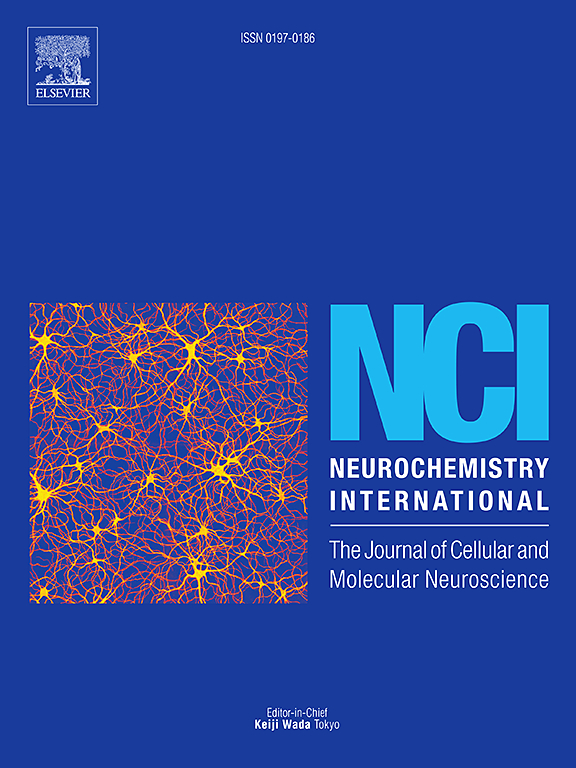Nicotine enhances object recognition memory through activation of the medial prefrontal cortex to the perirhinal cortex pathway
IF 4
3区 医学
Q2 BIOCHEMISTRY & MOLECULAR BIOLOGY
引用次数: 0
Abstract
Nicotine enhances recognition memory across species; however, the underlying neuronal mechanisms remain incompletely understood. Our previous study using a novel object recognition (NOR) test and electrophysiological recordings of mouse brain slices demonstrated that nicotine enhanced object recognition memory by stimulating nicotinic acetylcholine receptors in the medial prefrontal cortex (mPFC). To elucidate this further, we conducted the NOR test combined with pharmacology, chemogenetics, optogenetics, and ex vivo electrophysiology in male C57BL/6J mice. Chemogenetic inhibition of mPFC excitatory neurons suppressed nicotine-induced enhancement of object recognition memory, whereas their activation alone was sufficient to enhance memory. Anatomical studies indicate that the mPFC sends projections to the perirhinal cortex (PRH), a brain region involved in object recognition memory. Therefore, we focused on mPFC-PRH projections. Whole-cell patch-clamp recordings with optogenetic stimulation revealed that PRH pyramidal neurons received monosynaptic and glutamatergic inputs from the mPFC. Chemogenetic suppression of mPFC neurons projecting to the PRH blocked the nicotine-induced enhancement of object recognition memory, whereas activation of these neurons alone was sufficient to enhance memory. To achieve precise temporal control, optogenetic inhibition of the mPFC-PRH pathway during the training session blocked the effects of nicotine, and its activation alone enhanced memory. Furthermore, unilateral intra-mPFC nicotine infusion enhanced object recognition memory, and this effect was suppressed by ipsilateral intra-PRH infusion of an α-amino-3-hydroxy-5-methyl-4-isoxazole propionic acid (AMPA) receptor antagonist. These findings indicate that nicotine enhances object recognition memory by activating glutamatergic projections from the mPFC to PRH.
尼古丁通过激活内侧前额叶皮层至鼻周皮层通路增强物体识别记忆。
尼古丁增强了物种间的识别记忆;然而,潜在的神经元机制仍然不完全清楚。我们之前的研究使用了一种新的物体识别(NOR)测试和小鼠大脑切片的电生理记录,表明尼古丁通过刺激内侧前额叶皮层(mPFC)中的尼古丁乙酰胆碱受体来增强物体识别记忆。为了进一步阐明这一点,我们对雄性C57BL/6J小鼠进行了结合药理学、化学遗传学、光遗传学和离体电生理学的NOR测试。mPFC兴奋性神经元的化学发生抑制抑制了尼古丁诱导的物体识别记忆的增强,而它们的单独激活足以增强记忆。解剖学研究表明,mPFC向外皮层(PRH)发送投射,这是一个涉及物体识别记忆的大脑区域。因此,我们关注mPFC-PRH预测。光遗传刺激下的全细胞膜片钳记录显示,PRH锥体神经元接受来自mPFC的单突触和谷氨酸能输入。向PRH投射的mPFC神经元的化学发生抑制阻断了尼古丁诱导的物体识别记忆的增强,而单独激活这些神经元足以增强记忆。为了实现精确的时间控制,在训练过程中,光遗传学抑制mPFC-PRH通路可以阻断尼古丁的作用,而单独激活mPFC-PRH通路可以增强记忆。此外,单侧mpfc内尼古丁输注增强了目标识别记忆,这一作用被同侧prh内输注α-氨基-3-羟基-5-甲基-4-异恶唑丙酸受体拮抗剂抑制。这些发现表明尼古丁通过激活从mPFC到PRH的谷氨酸能投射来增强物体识别记忆。
本文章由计算机程序翻译,如有差异,请以英文原文为准。
求助全文
约1分钟内获得全文
求助全文
来源期刊

Neurochemistry international
医学-神经科学
CiteScore
8.40
自引率
2.40%
发文量
128
审稿时长
37 days
期刊介绍:
Neurochemistry International is devoted to the rapid publication of outstanding original articles and timely reviews in neurochemistry. Manuscripts on a broad range of topics will be considered, including molecular and cellular neurochemistry, neuropharmacology and genetic aspects of CNS function, neuroimmunology, metabolism as well as the neurochemistry of neurological and psychiatric disorders of the CNS.
 求助内容:
求助内容: 应助结果提醒方式:
应助结果提醒方式:


